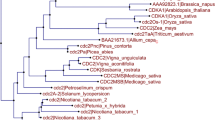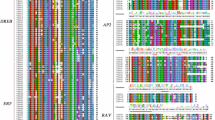Abstract
To unravel gene expression patterns during rice inflorescence development, particularly at early stages of panicle and floral organ specification, we have characterized random cloned cDNAs from developmental-stage-specific libraries. cDNA libraries were constructed from rice panicles at the stage of branching and flower primordia specification or from panicles undergoing floral organogenesis. Partial sequence analysis and expression patterns of some of these random cDNA clones from these two rice panicle libraries are presented. Sequence comparisons with known DNA sequences in databases reveal that approximately sixtyeight per cent of these expressed rice genes show varying degrees of similarity to genes in other species with assigned functions. In contrast, thirtytwo per cent represent uncharacterized genes. cDNAs reported here code for potential rice homologues of housekeeping molecules, regulators of gene expression, and signal transduction molecules. They comprise both single-copy and multicopy genes, and genes expressed differentially, both spatially and temporally, during rice plant development. New rice cDNAs requiring specific mention are those with similarity toCOP1, a regulator of photomorphogenesis inArabidopsis; sequence-specific DNA binding plant proteins like AP2-domain-containing factors; genes that specify positional information in shoot meristems like leucine-rich-repeat-containing receptor kinases; regulators of chromatin structure like Polycomb domain protein; and also proteins induced by abiotic stresses.
Similar content being viewed by others
References
Aida M., Ishida T., Fukaki H., Fujisawa H. and Tasaka M. 1997 Genes involved in organ separation inArabidopsis: An analysis of thecup-shaped cotyledon mutant.Plant Cell 9, 841–857.
Altschul S. F., Madden T. L., Schaffer A. A., Zhang J., Miller W. and Lipman D. J. 1997 Gapped BLAST and PSI-BLAST: A new generation of protein database search programs.Nucl. Acids Res. 25, 3389–3402.
Chung Y., Kim S., Finkel D, Yanofsky M. F. and An G. 1994 Early flowering and reduced apical dominance result from ectopic expression of a rice MADS box gene.Plant Mol. Biol. 26, 657–665.
Church G. M. and Gilbert W. 1984 Genomic sequencing.Proc. Natl. Acad. Sci. USA 81, 1191–1195.
Clark S. E., William R. W. and Meyerowitz E. M. 1997 TheCLAVATA1 gene encodes a putative receptor kinase that controls shoot and floral meristem size inArabidopsis.Cell 89, 575–585.
Cooke R., Raynal M., Laudie M., Grellet F., Delseny M., Morris P. C.et al. 1996 Further progress towards a catalogue of allArabidopsis genes: analysis of a set of 5000 non-redundant ESTs.Plant J. 9, 101–124.
Crawford N., Campbell W. H. and Davis R. W. 1986 Nitrate reductase from squash: DNA cloning and nitrate regulation.Proc. Natl. Acad. Sci. USA 83, 8073–8076.
Deng X. W., Matsui M., Wel N., Wagner D., Chu A. M., Feldman K. A. and Quail P. H. 1992COP1, an Arabidopsis regulatory gene, encodes a protein with both zinc-binding finger motif and aGΒ homologous domain.Cell 71, 791–801.
Goodrich J., Puangsomlee P., Martin M., Long D., Meyerowitz E. M. and Coupland G. 1997 A polycomb-group gene regulates homeotic gene expression inArabidopsis.Nature 386, 44–51.
Hoshikawa K. 1989The growing rice plant: an anatomical monograph. Nosan Gyoson Bunka Kyokai (Nobunkyo), Tokyo.
Jofuku K. D., den Boer B. G. W., Montagu M. and Okamuro J. K. 1994 Control ofArabidopsis flower and seed development by the homeotic geneAPETALA2.Plant Cell 6, 1211–1225.
Keith C. S., Hoang D. O., Barrett B. M., Feigelman B., Nelson M. C., Thai H. and Baysdorfer C. 1993 Partial sequence analysis of 130 randomly selected maize cDNA clones.Plant Physiol. 101, 329–332.
Klucher K. M., Chow H., Reiser L. and Fischer R. L. 1996 The Anintegumenta gene ofArabidopsis required for ovule and female gametophyte development is related to the floral homeotic gene Apetala 2.Plant Cell 8, 137–153.
Kushalappa K., Suresh Kumar M. B., Patwardhan L. and Vijayraghavan U. 1996 Isolation and characterization of genes controlling flowering in rice. InRice genetics III (Proceedings of the Third International Rice Genetics Symposium, ed. G. S. Khush), pp. 888–893. International Rice Research Institute, Manila.
Lin X., Kaul S., Rounsley S., Sha T. P., Banito M. I., Town C. D.et al. 1999 Sequence and analysis of chromosome 2 of the plantArabidopsis thaliana.Nature 402, 761–768.
Park Y. S., Kwak J. M., Kwon O. Y., Kim Y. S., Lee D. S., Cho M. J., Lee H. H. and Nam H. G. 1993 Generation of expressed sequence tags of random root clones ofBrassica napus by single-run partial sequencing.Plant Physiol. 103, 359–370.
Rogers S. O. and Bendich A. 1988 Extraction of DNA from plant tissues. InPlant molecular biology manual (ed. S. B. Gelvin and R. A. Schilperoort), pp. A6/1–10. Kluwer, Dordrecht.
Sablowski R. W. and Meyerowitz E. M. 1998 A homolog ofno apical meristem is an immediate target of the floral homeotic genesAPETALA3/PISTILLATA.Cell 92, 93–103.
Sambrook J. E., Fritsch F. and Maniatis T. 1989Molecular cloning. A laboratory manual. Cold Spring Harbor Laboratory Press Cold Spring Harbor.
Sasaki T., Song J., Koga-Ban Y., Matsui E., Fang F., Higo H.et al. 1994 Toward cataloguing all rice genes: Large-scale sequencing of randomly chosen rice DNAs from a callus cDNA library.Plant J. 6, 615–624.
Song W. Y., Wang G. L., Chen L. L., Kim H. S., Pil Y., Holsten T.et al. 1995 A receptor kinase like protein encoded by the rice disease resistance gene Xa21.Science 270, 1804–1806.
Souer E., van Houwelingen A., Kloos D., Mol J. and Koes R. 1996 Theno apical meristem gene of petunia is required for pattern formation in embryos and flowers and is expressed at meristem and primordia boundaries.Cell 85, 159–170.
Uchimiya H., Kldou S. L., Shimazaki T., Aotsuka S., Takamatsn S., Nishi R.et al. 1992 Random sequencing of cDNA libraries reveals a variety of expressed genes in cultured cells of rice (Oryza sativa L.).Plant J. 2, 1005–1009.
Vijayraghavan U. 1996 Genetic regulation of flower development.J. Biosci. 21, 379–395.
Weigel D. and Meyerowitz E. M. 1995 The ABCs of floral homeotic genes.Cell 78, 203–209.
Author information
Authors and Affiliations
Corresponding author
Rights and permissions
About this article
Cite this article
Kushalappa, K.M., Mattoo, A.K. & Vijayraghavan, U. A spectrum of genes expressed during early stages of rice panicle and flower development. J Genet 79, 25–32 (2000). https://doi.org/10.1007/BF02728942
Received:
Issue Date:
DOI: https://doi.org/10.1007/BF02728942




